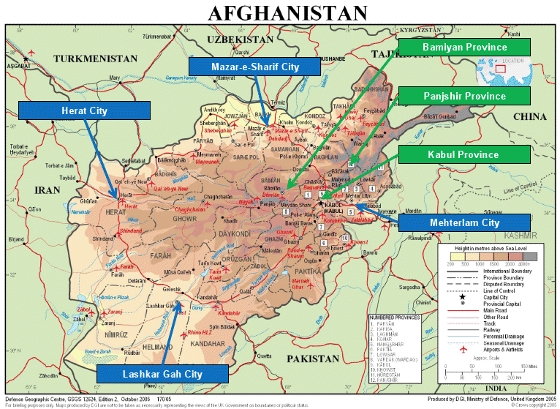
A central part of ISAF strategy is to build the Afghan National Security Forces (ANSF) so that they can progressively take over security in Afghanistan. The target date for turning over security for all of Afghanistan to the ANSF is the end of 2014. On March 21st, President Karzai announced the first phase of the transfer.
The transfer will include seven areas:
- Kabul province, Regional Command-Capital (RC-Capital), (population 3.5 million) including Kabul city proper plus the surrounding districts, except the eastern district of Surobi (population 150,000). The ISAF partner is Turkey, and the ANA unit responsible for this area is the 111st Capital Division.
- Bamyan Province, RC-East (population 340,000). The ISAF partner is New Zealand, and the ANA unit is the 1st Brigade 201st Corps.
- Panjshir Province, RC-East (population 139,000). The ISAF partner is the US, and the ANA unit is the 1st Brigade 201st Corps.
- Mehterlam City, capital of Laghman Province, RC-East (population 15,000). The ISAF partner is the US, and the ANA unit is the 3rd Brigade 201st Corps.
- Herat City, capital of Herat Province, RC-West (population 397,000). The ISAF partner is Italy, and the ANA unit is the 1st Brigade 207th Corps.
- Mazar-e-Sharif City, capital of Balkh Province, RC- North (population 275,000). The ISAF partner is Germany, and the ANA unit is 1st and 3rd Brigades 209th Corps.
- Lashkar Gah City, capital of Helmand province, RC-Southwest (population 201,000). The ISAF partner is the UK, and the ANA unit is the 3rd Brigade 215th Corps.
All of these are stable and less contentious areas. The ANA units are fairly mature. In Kabul, the ANSF has already been leading security operations for some time. And although Lashkar Gah is in the contentious southern province of Helmand, it is a relatively stable area within the province.
Taking security leadership does not mean that the ANSF will be self-sufficient. Although the ANSF will be responsible for planning and executing security operations, ISAF forces will still be present, but they will be thinned out. They will be responsible for combat support, logistics support, and training and mentoring the ANSF.
The transition will start in July 2011. This corresponds to the date that the Obama Administration has targeted since the start of the surge of forces into Afghanistan in 2009, and it was also agreed to by ISAF members at a NATO summit in November 2010.
The seven designated areas combined have a population of 4.8 million, or about 17% of Afghanistan’s total population. Projecting forward, at least this much of the country will have to be transferred to the ANSF each year, if all of Afghanistan is to be turned over by end 2014.
Are you a dedicated reader of FDD's Long War Journal? Has our research benefitted you or your team over the years? Support our independent reporting and analysis today by considering a one-time or monthly donation. Thanks for reading! You can make a tax-deductible donation here.







